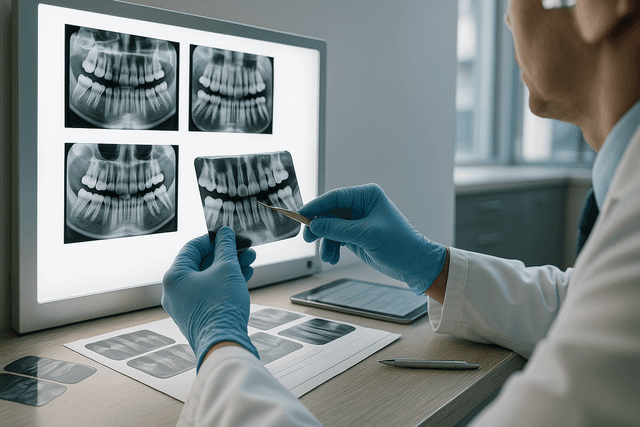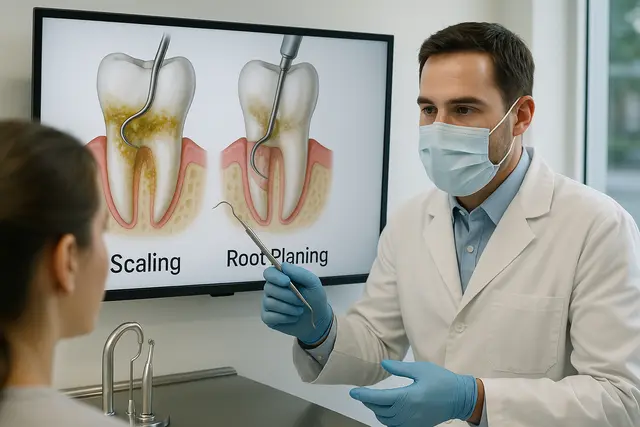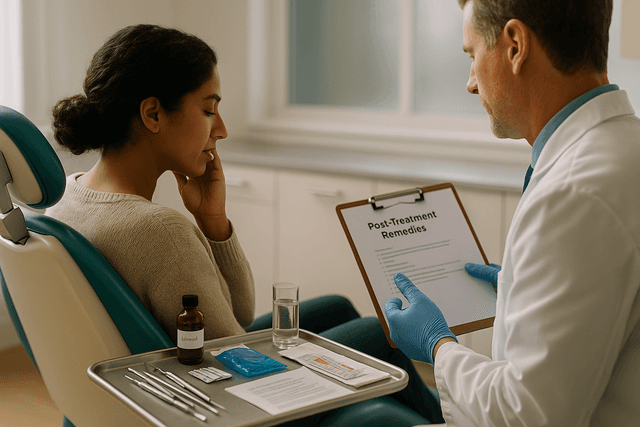General Dentistry
7 min read
Jul 17, 2025
Average Tooth Filling Cost: What Affects the Price You Pay?
Getting a cavity filled isn’t just a quick trip to the dentist; it can also be a hit to your wallet. While dental fillings are routine, the cost can vary more than most people expect. Understanding what influences the price can help you make smarter decisions about your care and avoid unpleasant surprises.

No one’s ever excited to hear, “You’ve got a cavity.” But if you’ve ever asked yourself, “How much does a filling cost?” you're definitely not alone. Whether it's a dull ache or a surprise discovery during a routine dental exam, the first thing that often comes to mind is the price tag.
The average cost of a dental filling can range from $100 to over $300 per tooth, depending on several not-so-fun variables. If you’re wincing already, hang tight. We’re going to break down the real factors behind that bill and help you walk into your next appointment with clarity, not sticker shock.
Filling Cost Depends on More Than Just the Tooth
You might think it’s as simple as drilling and patching things up, but tooth fillings are far from one-size-fits-all. The filling cost depends on where the tooth is located, how bad the cavity is, and what type of filling material is used. Molars? Trickier to get to. Front teeth? Easier, usually cheaper. More decay? More time, more effort, more cost.
And that’s not even getting into whether your dentist uses composite resin or an amalgam filling.
Tooth Location and Condition Play a Big Role
Think of your teeth like real estate, location matters. A cavity in a back molar often costs more to fill because it’s harder to reach and usually requires a larger amount of filling material. The condition of the tooth also makes a difference. A small cavity caught early is quicker and cheaper to fix than one that's been ignored for months and is starting to mess with the tooth structure.
Leaving a cavity untreated doesn’t just risk pain, it may also mean more expensive treatments down the line, like a dental crown or even tooth extraction. Catch it early, and you’ll save your tooth and your wallet.
Dental Fillings Are One of the Most Common Dental Procedures
Dental fillings are one of the most common dental procedures out there. Dentists do them every day. So even though you might feel anxious about it, your dental practice sees cavities and dental fillings as routine.
Most fillings take less than an hour and use local anesthetic to keep you comfortable. It’s a straightforward dental procedure, but prices can still vary widely based on a few sneaky details.
Types of Dental Fillings and How They Affect Price
Here’s where things get technical, and a little personal. The type of filling material you choose will directly affect how much you pay. Composite resin fillings are super popular because they blend in with your natural teeth. But that blend-in-beauty often comes with a higher cost. If you’re wondering why composite fillings cost more, it’s because the process takes longer and the materials are pricier.
Then there’s the trusty amalgam filling, made of a mix of metals. It’s strong, effective, and usually less expensive, but it's silver-colored, so not exactly subtle.
Composite Is the Most Popular for a Reason
Composite resin doesn’t just look better, it bonds directly to the tooth. That means it preserves more of the original tooth structure, which is great for your long-term dental health. If you're concerned about aesthetics or repairing a visible tooth, composite resin fillings are often the go-to.
Still, that clean look costs more. The composite filling process is more technique-sensitive, and some dentists consider it part of cosmetic dental work, especially for front teeth.
Amalgam Filling Is Cheaper but Noticeable
Amalgam fillings, also known as silver fillings, are a classic choice. They’re durable, less expensive, and last a long time. However, they’re also easier to spot and might not be the first pick if you're trying to keep your smile flawless. If you’re okay with the metallic look, they can be a more affordable dental option, especially for back teeth.
Cavity Filling Cost Can Vary Based on Severity
The size of the cavity matters more than you’d think. A tiny spot caught early? That’s a quick and relatively inexpensive fix. But a deep cavity that’s spread across multiple surfaces? That’s going to be a bit of a project, and yes, it’ll cost more.
Bigger cavities may also require more than just a simple filling. In some cases, the filling may not cut it, and your dentist may recommend a dental crown. The more complex the fix, the higher the cost.
Dental Insurance Can Lower Your Out-of-Pocket Cost
Let’s talk numbers. If you have dental insurance, your plan might cover 50% to 80% of the dental filling cost, especially if it's considered medically necessary and not cosmetic. That can take a huge chunk off your bill.
But not all insurance plans are created equal. Your dental insurance plan may have rules about which type of filling material is covered. Many dental insurance plans pay for amalgam fillings but might not fully cover composite unless it’s on a front tooth. So be sure to check with your provider before your appointment.
Without Insurance It’s a Whole Different Story
If you're paying out of pocket, the filling cost without insurance can be a big surprise. On average, the cost of a dental filling ranges from $150 to $300 per tooth. Composite can cost closer to $250 or more, while amalgam may be around $100 to $150.
Without insurance, dental costs add up quickly, especially if you need multiple fillings. Some dental clinics offer a discount dental plan to help patients pay less. Ask your local dental office if they offer in-house memberships or payment plans.
Many dental offices offer payment plans, credit options like CareCredit, or sliding-scale pricing based on income. The actual cost comes down to three big things:
How big the cavity is
Which tooth needs fixing
Whether you have insurance
Add in your location (yep, cost of living affects this too), and you’ll start to see why prices vary so much.
According to the Synchrony average procedural cost study and the American Dental Association, the national average cost for a tooth filling hovers around $200 to $300 per tooth. But again, composite costs more than amalgam, and some dental work may fall outside the standard range.
Cost Tables Can Be Misleading
If you’ve ever googled “how much does a cavity filling cost,” you’ve probably seen some tidy cost tables. While they’re helpful for ballpark numbers, they often don’t account for things like the complexity of the procedure, your dentist’s rates, or whether you're having a dental emergency.
And let’s not forget about extra fees for things like the dental exam, X-rays, or numbing agents. Those aren’t always included in that neat little cost chart.
Dental Exam Is Key Before Any Dental Filling Procedure
Before your dentist grabs the drill, they’ll need to check what’s really going on. A thorough dental exam will help determine the size of the cavity, condition of the tooth, and the best filling option. That’s also when they’ll give you a clearer idea of your total cost.
Skipping regular dental exams may seem like a money-saver, but they can actually help you avoid bigger problems (and bills) down the road. Regular dental care is your first defense against severe dental issues that could lead to extra procedures, or worse, tooth extraction.
Tooth Extraction Is a Last Resort
No one wants to hear that their tooth can't be saved, but in some cases, a cavity gets so bad that a tooth extraction is the only option. Compared to a filling, the cost of tooth extraction can range from $75 to over $300, not including any follow-up work like a dental crown or implant.
And trust us, it’s not just more expensive, it’s more painful and complicated. Better to fix the tooth early and skip the drama.
Cost for Tooth Repair Varies by Dentist and Location
Where you live can absolutely influence the cost. Urban dental practices often charge more than rural ones simply due to overhead and local demand. Also, the experience of your dentist, the quality of the materials they use, and the reputation of the dental clinic all factor into the final price.
Even within the same city, the cost for tooth repair can differ based on the dental practice you choose. It’s worth calling around, or asking your regular dentist if they offer affordable dental options or price matching.
Dental Filling Without Insurance Is Still Possible
If you're stressed about affording treatment, you’re not alone. Many dental offices offer payment plans, credit options like CareCredit, or sliding-scale pricing based on income. Dental schools and community clinics may offer affordable dental services with supervision from licensed professionals.
Just because you don’t have insurance doesn’t mean you have to live with a cavity, or worse, risk tooth loss. You have options. And getting it fixed sooner can save you more in the long run.
How Much Does a Typical Tooth Filling Cost?
The average cost of a tooth filling ranges from $100 to $300 per tooth, but the final price depends on several factors. These include the size of the cavity, the location of the tooth, and the type of material used. Composite fillings (tooth-colored) usually cost more than amalgam fillings (silver-colored).
What’s the Difference Between Composite and Amalgam Fillings?
Composite fillings are made from tooth-colored resin and are popular for visible teeth because they blend in naturally. They cost more and take longer to place. Amalgam fillings are made from a mix of metals, are more noticeable due to their silver color, but are typically cheaper and extremely durable—especially for back teeth.
Does Dental Insurance Cover Cavity Fillings?
Most dental insurance plans cover 50% to 80% of the cost of cavity fillings, especially if the procedure is medically necessary. However, many plans only fully cover amalgam fillings, not composite, unless the composite is placed in a front tooth for cosmetic reasons. Always check with your insurance provider before your appointment.
What If I Don’t Have Dental Insurance?
If you’re paying out of pocket, the cost of a filling can be anywhere from $150 to $300 or more per tooth. Many dental offices offer payment plans, discount memberships, or sliding-scale pricing to help make treatment more affordable. Some dental schools and community clinics also provide low-cost options.
Can I Avoid More Expensive Dental Procedures by Getting a Filling Early?
Yes. Early treatment saves money and prevents more complicated procedures. A small cavity is cheaper and easier to fix. If you wait too long, the decay can spread, leading to the need for a crown, root canal, or even tooth extraction, which are far more costly and invasive. Regular dental check-ups can help catch cavities before they become serious.
Read Next
Related Posts

General Dentistry
How to Read Dental X-Rays: A Visual Guide to Oral Health Clues
Dental x-rays may look like abstract black-and-white images, but they play a powerful role in uncovering what's really going on beneath the surface of your smile. From detecting hidden cavities to revealing signs of gum disease, these diagnostic tools are essential for maintaining oral health and catching problems early.
6 min read
Sep 10, 2025

General Dentistry
What Is SRP in Dentistry? A Complete Guide to Scaling and Root Planing
When it comes to dental health, most people think regular cleanings are enough to keep their smile safe. But sometimes, what’s happening below the gumline needs more attention. Scaling and root planing (SRP) is a treatment designed to address gum disease at its source, protecting both your gums and teeth from long-term damage.
5 min read
Sep 10, 2025

General Dentistry
Do Cavity Fillings Hurt After? What to Expect Post-Treatment
Tooth fillings are a routine dental procedure, but that doesn’t mean they’re without aftereffects. Many patients find themselves surprised by lingering discomfort or sensitivity once the anesthesia wears off. Understanding what’s normal, and what isn’t, can ease your mind and help you heal more comfortably.
4 min read
Sep 08, 2025
Don’t have time to research every dentist around you?
See why 30k+ patients trusted us